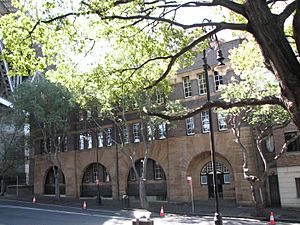Old Mining Museum Building facts for kids
Quick facts for kids Mining Museum (former) |
|
|---|---|

Old Mining Museum Building
|
|
| Location | 36–64 George Street, The Rocks, City of Sydney, New South Wales, Australia |
| Built | 1902–1909 |
| Architect | Walter Liberty Vernon |
| Architectural style(s) | Federation Warehouse |
| Owner | Property NSW |
| Official name: Mining Museum (former); Earth Exchange; Sydney Geological and Mining Museum | |
| Type | State heritage (built) |
| Designated | 10 May 2002 |
| Reference no. | 1555 |
| Type | historic site |
| Lua error in Module:Location_map at line 420: attempt to index field 'wikibase' (a nil value). | |
The Old Mining Museum building in The Rocks, Sydney, is a special historic building. It used to be a place where scientists studied chemicals and a museum about mining. Today, it's a commercial building.
This building is located on George Street and was designed by a famous architect named Walter Liberty Vernon. It was built between 1902 and 1909. Over the years, it has been known by different names, like the Earth Exchange and the Sydney Geological and Mining Museum. It's an important part of New South Wales history and is listed on the State Heritage Register.
Contents
A Look Back: The Building's Story
Early Days: From Empty Land to Power Station Plans
For a long time, this spot in Sydney was just empty land. Maps from the late 1700s show no buildings here. Later, in 1807, the land was leased to a person named Robert Campbell.
Around 1902, the area was an old quarry, a place where stone was dug out of the ground. Plans were made to build an electric power station and workshops here. The famous architect Walter Vernon drew up these plans.
Building a Museum: A New Purpose
Between 1902 and 1904, the lower part of the building was constructed for the power station. However, the power station was never finished or used. The generating equipment was never even installed!
By 1908, the land was given to the NSW Mines Department. They decided to use the unfinished building for something new. Between 1908 and 1909, the upper levels were built to create a mining museum and chemical laboratories. The Mining Museum officially opened its doors in August 1909.
The "War of the Currents" and the Building's Design
Interestingly, this building was first planned as a power station during a time called the "War of the Currents." This was a big debate about how electricity should be supplied. Thomas Edison strongly supported Direct Current (DC), but Alternating Current (AC) eventually became the standard everywhere. Because AC power became more popular, this DC power station was never actually used.
Changes Over the Years: Art, Earth, and Offices
The building saw many changes after it became a museum. In 1930, the Julian Ashton Art School moved into the first floor. Later, in 1972, a museum shop was added. The art school moved out the following year.
In 1989, the building's name changed to The Earth Exchange. It reopened in March 1991 after some major updates. However, the museum closed permanently in 1996. Since then, the building has been used for offices.
What the Building Looks Like
A Grand Design with a Tall Chimney
The Old Mining Museum building is quite impressive. It has six floors and a very tall chimney stack, which is about 61 meters (200 feet) high. The building faces two important streets: George Street and Hickson Road.
Because of how it's built into the hillside, George Street is about three stories higher than Hickson Road at this spot. The building stands out in the area, especially with its tall chimney and large size.
Materials and Style
The building is made from a mix of sandstone, brick, and rendered (smoothly coated) walls. The roof has several gables and special sawtooth roof lights that let in natural light.
Inside, it has a strong frame of steel columns and beams. Some floors are concrete, and others are timber. The building's style is called "Federation Warehouse," but it also has some cool details from the Art Nouveau and Romanesque styles.
Building Condition and Updates
The building has been well-maintained over the years. Major internal work was done in 1990 when it was getting ready to reopen as The Earth Exchange.
Why This Building is Special
A Link to History and Science
The Old Mining Museum building is very important for its history and scientific value in New South Wales. It shows how people have been collecting and studying minerals and geological objects for almost 90 years.
It's also a great example of the Federation Warehouse style, designed by a very important architect, Walter Liberty Vernon. He was the first Government Architect for New South Wales.
A Landmark in Sydney
This building is a distinctive landmark in The Rocks and near Circular Quay. Its unique style and tall chimney make it easy to spot. It's also special because it was first planned as a power station, then changed into a museum and chemical laboratory. This makes it a rare example of a building that changed its purpose so much.
The building also reminds us of the big decision to switch from DC to AC electricity in New South Wales.
Education and Community
For many years, the museum and laboratories played a big role in educating people. From miners to the general public, many learned about minerals and geology here. This connection to learning and research lasted from 1908 until 1995.
See also
- Australian non-residential architectural styles
- Metcalfe Bond Stores

